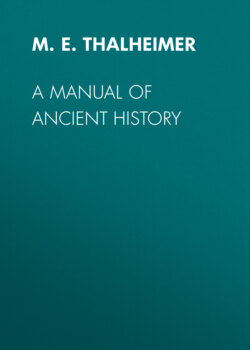A Manual of Ancient History

Реклама. ООО «ЛитРес», ИНН: 7719571260.
Оглавление
M. E. Thalheimer. A Manual of Ancient History
A Manual of Ancient History
Table of Contents
INTRODUCTION
SOURCES AND DIVISIONS OF HISTORY
BOOK I. Nations of Asia and Africa from the Dispersion at Babel to the Foundation of the Persian Empire. BC (about) 2700–558
PART I. ASIATIC NATIONS
VIEW OF THE GEOGRAPHY OF ASIA
CHALDÆAN MONARCHY
ASSYRIAN MONARCHY
Kings of Assyria
Kings of the Second Period
Kings of the Third Period
RECAPITULATION
MEDIAN MONARCHY
Known Kings of Media
BABYLONIAN MONARCHY
RECAPITULATION
KINGDOMS OF ASIA MINOR
Kings of Lydia
PHŒNICIA
Kings of Tyre. First Period
Second Period
SYRIA
Kings of Damascus
JUDÆA
Rulers and Judges of Israel. Under the Theocracy
Kings of the United Monarchy
Kings of Israel
Kings of Judah
RECAPITULATION
QUESTIONS FOR REVIEW. Book I.—Part I
PART II. AFRICAN NATIONS
GEOGRAPHICAL OUTLINE OF AFRICA
HISTORY OF EGYPT. Periods
RECAPITULATION
RELIGION OF EGYPT
CARTHAGE
RECAPITULATION
QUESTIONS FOR REVIEW. Book I.—Part II
BOOK II. The Persian Empire from the Rise of Cyrus to the Fall of Darius. BC 558–330
RECAPITULATION
Persian Religion
RECAPITULATION
Reign of Xerxes I
RECAPITULATION
QUESTIONS FOR REVIEW. Book II
BOOK III. Grecian States and Colonies from their Earliest Period to the Accession of Alexander the Great
GEOGRAPHICAL OUTLINE OF GREECE
HISTORY OF GREECE
Periods
RECAPITULATION
Second Period. BC 1100–500
Sparta
RECAPITULATION
Grecian Colonies
RECAPITULATION
Third Period. BC 500–338
RECAPITULATION
Growth of Athens
RECAPITULATION
Supremacy of Athens
RECAPITULATION
The Peloponnesian War
RECAPITULATION
The Sicilian Expedition
RECAPITULATION
Decline of Athens
RECAPITULATION
Spartan Supremacy
RECAPITULATION
Supremacy of Thebes
RECAPITULATION
QUESTIONS FOR REVIEW. Book III
BOOK IV. History of the Macedonian Empire and the Kingdoms formed from it, until their Conquest by the Romans
First Period. From the Rise of the Monarchy to the Death of Alexander the Great, about BC 700–323
RECAPITULATION
Second Period. From the Death of Alexander to the Battle of Ipsus, BC 323–301
RECAPITULATION
Third Period. History of the Several Kingdoms into which Alexander’s Empire was divided
I. The Syrian Kingdom of the Seleu´cidæ. BC 312–65
RECAPITULATION
II. Egypt under the Ptolemies. BC 323–30
RECAPITULATION
III. Macedonia and Greece
RECAPITULATION
IV. Thrace
V. Kingdom of Pergamus
VI. Bithynia
VII. Pontus
VIII. Cappadocia
IX. Armenia
X. Bactria
XI. Parthian Empire of the Arsacidæ
RECAPITULATION
XII. Judæa
RECAPITULATION
QUESTIONS FOR REVIEW. Book IV
BOOK V. History of Rome, from the Earliest Times to the Fall of the Western Empire, AD 476
GEOGRAPHICAL SKETCH OF ITALY
HISTORY OF ROME
RECAPITULATION
Religion of Rome
RECAPITULATION
II. The Roman Republic
RECAPITULATION
The Laws of the Twelve Tables
RECAPITULATION
Capture of Rome by the Gauls
RECAPITULATION
Second Period, BC 343–264
RECAPITULATION
War with Pyrrhus
RECAPITULATION
Third Period, BC 264–133
RECAPITULATION
Extension of Roman Power
RECAPITULATION
Fourth Period, BC 133–30
RECAPITULATION
The Social War
RECAPITULATION
Conquests of Julius Cæsar
RECAPITULATION
Cæsar Master of Rome
RECAPITULATION
III. The Roman Empire
RECAPITULATION
Decline of the Empire
RECAPITULATION
Second Period, AD 193–284
RECAPITULATION
Third Period, AD 284–395
RECAPITULATION
Extinction of Paganism
RECAPITULATION
Fourth Period, AD 395–476
RECAPITULATION
QUESTIONS FOR REVIEW. Book V
LIST OF BOOKS RECOMMENDED
FOOTNOTES
INDEX
Отрывок из книги
M. E. Thalheimer
Published by Good Press, 2019
.....
31. Asshur-danin-il II was less warlike than his ancestors. The time of his reign is ascertained by an eclipse of the sun, which the inscriptions place in his ninth year, and which astronomers know to have occurred June 15, 763 BC After Asshur-likh-khus, the following king, the dynasty was ended with a revolution. Nabonas´sar, of Babylon, not only made himself independent, but gained a brief supremacy over Assyria. The Assyrians, during the Second Period, made great advances in literature and arts. The annals of each reign were either cut in stone or impressed upon a duplicate series of bricks, to guard against destruction either by fire or water. If fire destroyed the burnt bricks, it would only harden the dried; and if the latter were dissolved by water, the former would remain uninjured. Engraved columns were erected in all the countries under Assyrian rule.
BC 745–727.
.....